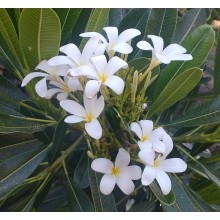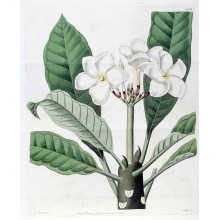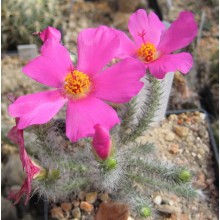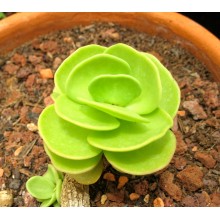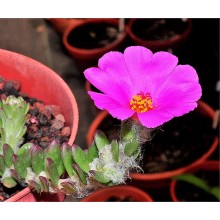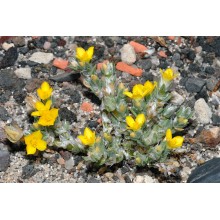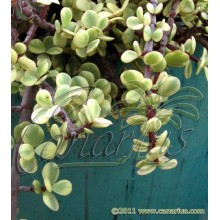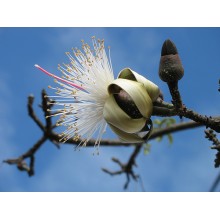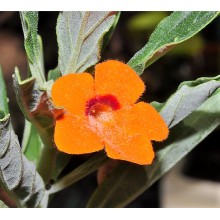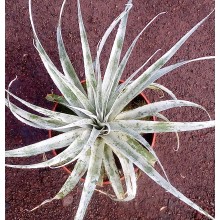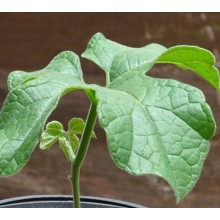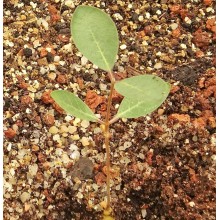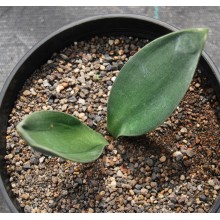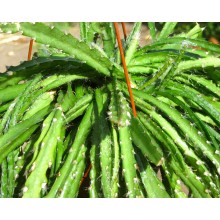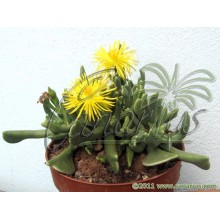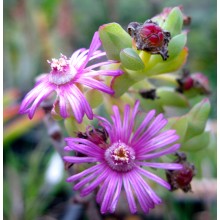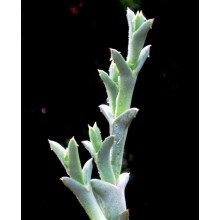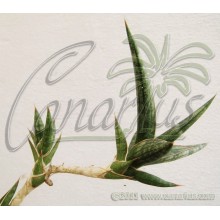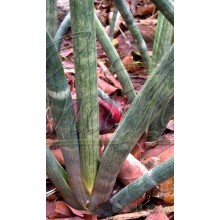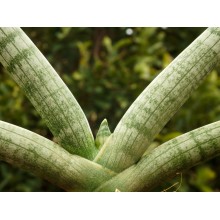Succulents There are 628 products.

World deserts and dry areas are home to the most interesting plants. Canarius offers an increasing selection of succulent plants of maximum quality, because they are grown outdoors, under the full sun of the Canary Islands.
Succulents or "fat plants" are water-retaining species, adapted to dry conditions. They store succum (juice, water) in their leaves, stems or roots, and often show a stout and fleshy appearance.
Subcategories
-
Agave
Agave is a genus of succulent plants from America. Some species grow in cold areas and take hard frost, while some others live in tropical climates. Some are tiny dwarfs and some are giants, up to 2 or 3 m wide.
Cold hardy agaves can create an exotic effect in your garden. Agave species make fine companions to palms or cacti. Variegated agaves are incredibly sought after by collectors. Our web shop offers an ever changing selection of species. We ship bare rooted plants, unless otherwise specified.
-
Aloe, Gasteria & Haworthia
Aloe, Gasteria and Haworthia are three related genera, comprising hundreds of succulent plants. They are all easily grown in pots. A few adapt to low-light levels of indoor conditions and can be grown as house plants.
- Aloe is a genus of about 400 species, native to Africa, Arabia and Madagascar. Small or dwarf aloes are becoming especially popular in colder climates as they can be taken indoors during the hardest months.
- Gasteria includes some 80 species endemic to South Africa, known for their spectacular leaves which are glossy, mottled and textured. They bloom in Spring-Summer with long spikes of small orange flowers. Some species are so variable that we offer particular clones from specific locations.
- Haworthia is a genus endemic to South Africa with about 70 species and a number of local subspecies, varieties and forms. Leaves are often banded, speckled, dotted, or semi-translucent and show wide variations.
-
Crassulaceae
This is a new, growing section of species from the family Crassulaceae. There are about 1,400 species in 33 genera and their distribution is worldwide, but mostly occur in the Northern Hemisphere and Southern Africa, especially in dry habitats. Here you can buy healthy, sun-hardened plants grown in the Canary Islands and shipped to your home.
-
Mesembs
This group of desert plants is briefly named Mesembs because they belong to a botanical family formerly named Mesembryanthemaceae. There are almost 2.000 species, mainly found in Southern Africa, with extreme adaptations to dry habitats. Some are called "living stones", as they look like pebbles. Many are easy to grow and their main need is full sun. Some are difficult because they grow in truly extreme areas.
Our Web Shop offers sun grown healthy plants, with compact and colourful leaves. Some plants are sold as cuttings, and others as rooted plants, of at least two years old.
-
Sansevieria
Recently assigned to the family Asparagaceae, the genus Sansevieria counts about 70 species, nearly all native to Africa, Arabia and Madagascar. Perennial herbs adapted to dry habitats with stiff, succulent leaves, their length ranges from a few centimeters to 2 meters. Sansevieria trifasciata and its many cultivars are among the most popular houseplants, popularly called mother in law's tongue. A well grown plant usually produces a spike of many white, richly scented flowers and then orange berries. Even the rarest species are resistant to neglect, provided you keep them from frost in winter and scorching sun in summer.
-
Hoya
Hoyas are twining vines, with showy exotic flowers, from the rainforests in Asia and Oceania. Most species grow in bright shade or morning sun, but they will also grow indoors as house plants. They are well suited for baskets, trellises or ladders. They tolerate a few weeks of drought but they are sensitive to frost and cold. Many hoyas are easy to grow and bloom, while some are tricky and rare.
-
Asclepiads
Asclepiads or Asclepiadoideae are a subfamily in the Apocynaceae, with about 2900 species. There are lots of leafless stem succulents but also perennial herbs, shrubs, lianas or rarely trees. They produce remarkable flowers, for the complex mechanisms they have developed for pollination. Many species produce an unusual fragrance, often called "carrion", and attracts flies for pollination. -
Caudiciforms
These plants from dry areas produce an unusually thick stem, the caudex. They are also called pachycauls and they have a disproportionately thick trunk, often with few branches. The caudex can be hidden underground, but in most cases they grow upwards, forming spectacular trees. The largest caudiciforms in the world are the baobabs. -
Other succulents
Here you will find all those species of desert plants that are not included in their own category. We will place here all plants from unusual families, other than Agaves, Aloes, Crassulaceae, Sansevieria, Mesembs, Epiphytic cacti, etc.
-
Plumeria obtusa 'Cuban Dwarf'
Plumeria obtusa 'Cuban Dwarf'
Dwarf, shrubby plumeria, probably selected from the wild forms of Plumeria obtusa that grow on the hills in Northern Cuba.
34,20 € -
Plumeria rubra - Wild Type
Plumeria rubra - Wild Type
This is a wild form of Plumeria rubra, not a hybrid or a selection as ALL the ones you will find in the trade. Wild types are tough guys from the coastal scrubs of Central America, able to withstand truly harsh conditions. It is very vigorous with large leaves. Flowers are white with a yellow center.
42,00 € -
Portulaca eruca
Portulaca eruca
Beautiful shrublet, all coated in white hairs. It blooms easily and the pink flowers look comparatively enormous!
16,50 € -
Portulaca molokiniensis
Portulaca molokiniensis
1-2 year old seedling. The Hawaiian archipelago is known for its lush tropical vegetation and few succulents occur in the native flora. This portulaca is a hard-to-find gem, admired by collectors for its compact, symmetrical habit. Well grown plants are truly beautiful and bear yellow flower heads. This endangered species only occurs on a few islets.
24,50 € -
Portulaca werdermannii
Portulaca werdermannii
Cute portulaca species, branched, with very hairy leaves and showy purple flowers. It blooms profusely through the warmer months of the year.
20,50 € -
Portulaca wightiana
Portulaca wightiana
Tuberous" Portulaca with a thick caudex taproot, with stems bushily branched, articulated, up to 7 cm high It blooms profusely with yellow flowers and this miniature makes a very ornamental effect.
16,30 € -
Portulacaria afra variegata
Portulacaria afra variegata
Cont.= 8,5 cm. Variegated selection of the popular succulent shrub with small round leaves. This cultivar has a beautiful cream and green variegation. The stems are reddish brown. It is very easy to grow, but slow.
10,40 € -
Pseudobombax ellipticum "white flower"
Pseudobombax ellipticum "white flower"
.We offer plants of 3 cm caudex.
31,60 € -
Puya harmsii- Large
Puya harmsii- Large
Beautiful large Puya with grey-white leaves with few spines, up to 1 m tall, forming clusters with age It bears showy inflorescences, 2 m tall, with blue-black flowers from purple-pink bracts. It is known from a few restricted location at high altitude in the provinces of Tucuman and Catamarca, in northwestern Argentina.
51,30 € -
Raphionacme lanceolata
Raphionacme lanceolata
Caudex-forming asclepiad with scrambling stems. It builds a sub-spherical caudex, up to 35 cm in diameter. The velvety stems grow up to 50 cm long and spread horizontally. Leaves are also more or less densely velvety on both surfaces
26,00 € -
Rauhia multiflora
Rauhia multiflora
South american xerophytic bulb, with large, remarkable succulent leaves. The bulb is coated by papery brown sheaths and holds 1-4 leaves, but most often a pair of two. These are beautifully channeled, ovate-rounded, tongue-like. held on wide petioles.
12,30 € -
Rhombophyllum rhomboideum
Rhombophyllum rhomboideum
- Branched plant, Cont.= 8,5 cm. Grows in open limestone gravely patches in the subtropical thicket vegetation areas around Port Elizabeth and Uitenhage in So.Africa. The area has mild coastal temperatures and both summer and winter rainfall.
10,30 € -
Ruschia maxima
Ruschia maxima
NEW! - Two 20 cm cuttings. Ornamental succulent shrub,30-100 cm tall, with simmetrical blue leaves with a pink tinge andbright pink flowers. It is widespread in South Africa and standsfrosts, fires and drought. It does well
10,80 € -
Sansevieria ballyi 12681
Sansevieria ballyi 12681
One mature rosette, 5-8 cm diameter. A miniature creeping Sansevieria, with spiky tight rosettes on stolons. This "Bally 12681" from Kenya is surely the smallest and the cutest of all the species! Easy and fast growing. Good for terrariums and for hanging baskets.
17,20 € -
Sansevieria cylindrica Banded Leaves
Sansevieria cylindrica Banded Leaves
NEW ! Large head with leaves of 30-40 cm - This species has cylindrical smooth leaves with a green-gray banding.Old plants in the ground can reach 1-2 m in height.
6,95 € 13,90 €Reduced price! -
Sansevieria cylindrica var. patula
Sansevieria cylindrica var. patula
Patula is the most compact variety of the popular Sansevieria cylindrica. Leaves are cute and chubby, silvery and banded in high light. Solitary plants often resemble a chubby human hand !
18,30 €
At the moment there are few products in this category Succulents

























